| ° |
Queens
& males only (image of queen on species page)
|
Somalia
- somalica
|
| ° |
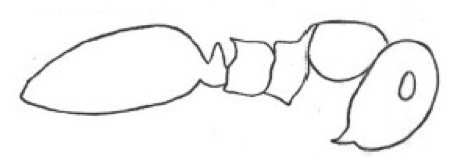 TL
2.5 mm; petiole not
described; scapes surpass occiput by 0.4 of their length; head and
alitrunk microscopically punctate, sides of
mesonotum longitudinally striate; dark castaneous brown, gaster black,
antennae, tibiae
& tarsi yellow-brown; close to depressa
(Santschi 1914b) TL
2.5 mm; petiole not
described; scapes surpass occiput by 0.4 of their length; head and
alitrunk microscopically punctate, sides of
mesonotum longitudinally striate; dark castaneous brown, gaster black,
antennae, tibiae
& tarsi yellow-brown; close to depressa
(Santschi 1914b) |
Tanzania - deplanata
|
| ° |
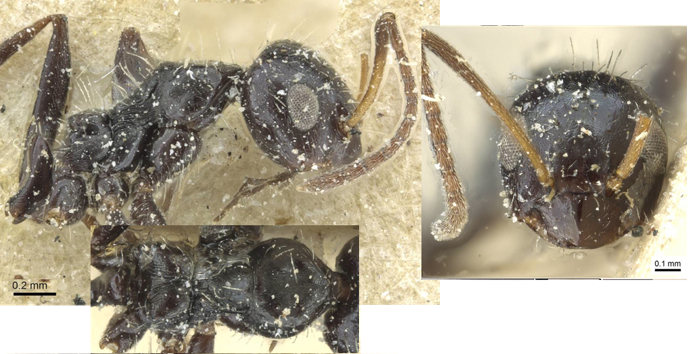 Apparently undescribed, SI 110; probably an example of L. hirsuta Apparently undescribed, SI 110; probably an example of L. hirsuta
|
West
Africa
& Congo Basin - fervida |
| - |
Major
workers
|
- |
| 0 |
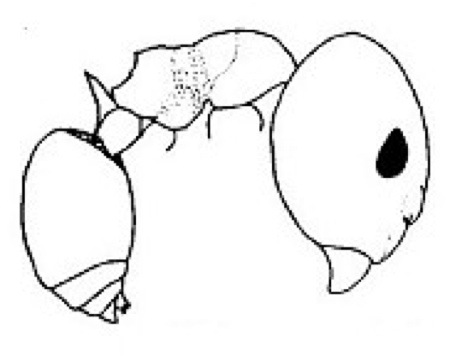 TL
4.3 mm (assumed major) HL 1.54 HW 1.45, CI 94, scapes reaching 2/3 back
to occiput;
petiole with acute dorsal spines about as long as interval between
their bases; head densely and finely punctate; bicoloured - head
mahogany red, rest of body black; the fine whitish erect hairs suggest
an affinity with capitata (below). TL
4.3 mm (assumed major) HL 1.54 HW 1.45, CI 94, scapes reaching 2/3 back
to occiput;
petiole with acute dorsal spines about as long as interval between
their bases; head densely and finely punctate; bicoloured - head
mahogany red, rest of body black; the fine whitish erect hairs suggest
an affinity with capitata (below).
|
South
Sudan - megacephala |
| -- |
 TL
3.2-3.6 mm, CI 103-115, SI 79-82 ; in full
face
view eyes distant from edges of face (for minor worker see 45) TL
3.2-3.6 mm, CI 103-115, SI 79-82 ; in full
face
view eyes distant from edges of face (for minor worker see 45) |
. |
| . |
 |
West Africa & Congo
Basin
- cacozela |
| -- |
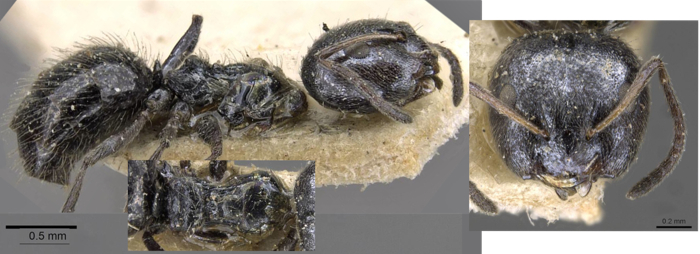 TL
3 mm, SI 63; occipital margin distinctly impressed; scapes just failing
to
reach occiput; propodeum with obtuse teeth; petiole emarginate but
without spines or even teeth; legs relatively short; head weakly shiny
but abundantly and grossly punctate; erect hairs
yellowish fairly oblique and with quite dense yellowish pubescence;
black, appendages reddish, femora brown TL
3 mm, SI 63; occipital margin distinctly impressed; scapes just failing
to
reach occiput; propodeum with obtuse teeth; petiole emarginate but
without spines or even teeth; legs relatively short; head weakly shiny
but abundantly and grossly punctate; erect hairs
yellowish fairly oblique and with quite dense yellowish pubescence;
black, appendages reddish, femora brown |
Congo
Basin - capitata |
| - |
Workers |
- |
| 1 |
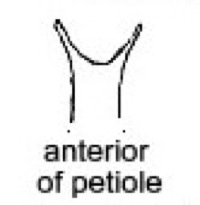 Petiole with a pair
of long,
usually sharp, spines on dorsal margin Petiole with a pair
of long,
usually sharp, spines on dorsal margin |
2 |
| -- |
 Petiole
emarginate or with
denticles or spines that are much shorter than the width of the petiole
apex Petiole
emarginate or with
denticles or spines that are much shorter than the width of the petiole
apex |
18 |
| 2 |
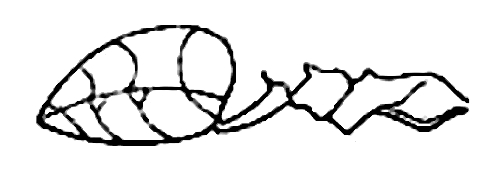 Petiole
very long, two and a half times as long
as the node is high, petiole spines long, thin and straight Petiole
very long, two and a half times as long
as the node is high, petiole spines long, thin and straight |
3 |
| -- |
Petiole short,
little or nor longer than node is high |
5 |
| -- |
Petiole much longer than height of
node |
-- |
| 3 |
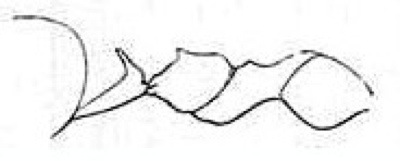 TL
2.8-3.1 mm, CI 82, SI 166; head elongate ovoid, occiput straight; eyes
about 0.33 X length of side of head; erect hairs scanty, whitish-yellow
and fairly long; head and alitrunk
ochreous, smooth and shining TL
2.8-3.1 mm, CI 82, SI 166; head elongate ovoid, occiput straight; eyes
about 0.33 X length of side of head; erect hairs scanty, whitish-yellow
and fairly long; head and alitrunk
ochreous, smooth and shining |
. |
| . |
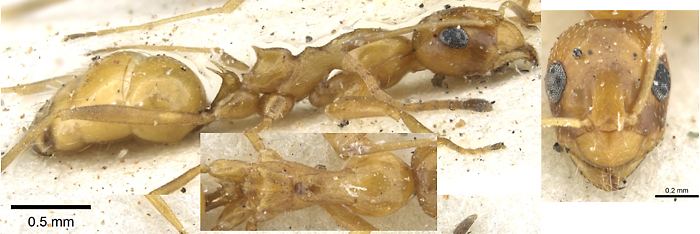 |
Zimbabwe
& South Africa
- arenaria |
| -- |
Head and alitrunk
reddish-brown, dull and reticulate-punctate |
4 |
| 4 |
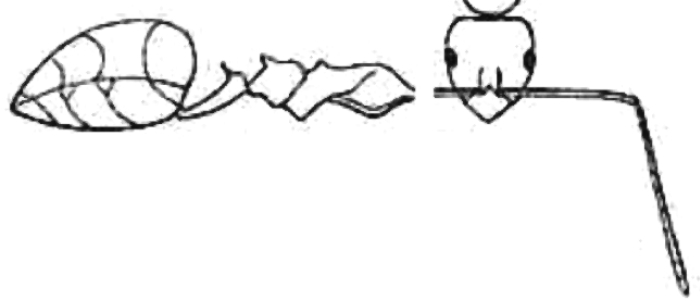 TL 3.0-3.8 mm, CI 88,
SI 150;
gaster with short, black and obtuse hairs TL 3.0-3.8 mm, CI 88,
SI 150;
gaster with short, black and obtuse hairs |
. |
| . |
 |
Zimbabwe
& South Africa
- longinoda |
| -- |
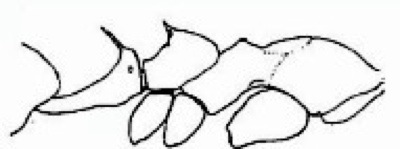 TL
2.4 mm; erect hairs whitish clear, gaster
more slender and shiny than longinoda;
spines on petiole even longer and narrower TL
2.4 mm; erect hairs whitish clear, gaster
more slender and shiny than longinoda;
spines on petiole even longer and narrower |
Angola - angolensis |
| -- |
Petiole short |
-- |
| 5 |
Petiole
as high or higher than propodeum, with
long coarse spines |
5A |
| -- |
Petiole clearly
lower than propodeum and with narrow sharp spines |
6 |
| 5A |
 TL
3.3 mm, scape exceeding occiput by about half its length; heavily
sculptured, with head, petiole
and gaster finely and densely reticulate-punctate, alitrunk grossly
rugose; erect hairs restricted to clypeus and apex of gaster; dark
red-brown
almost black TL
3.3 mm, scape exceeding occiput by about half its length; heavily
sculptured, with head, petiole
and gaster finely and densely reticulate-punctate, alitrunk grossly
rugose; erect hairs restricted to clypeus and apex of gaster; dark
red-brown
almost black |
Angola
- rugithorax |
| -- |
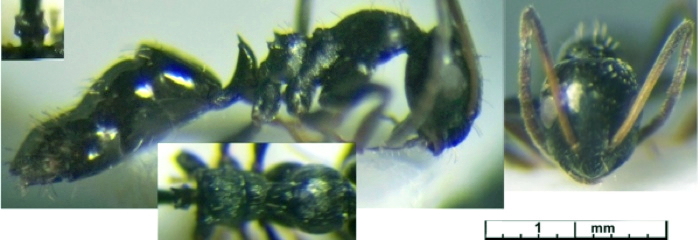 TL ca 3.4 mm, SI 144; sculpturation on alitrunk dense
spiculation; head and alitrunk with sparse short pale hairs TL ca 3.4 mm, SI 144; sculpturation on alitrunk dense
spiculation; head and alitrunk with sparse short pale hairs |
Cameroun - n
sp Cameroun FK 70 |
| -- |
 TL ca 3.4 mm, SI 144; sculpturation on alitrunk dense
spiculation; head and alitrunk with sparse short pale hairs TL ca 3.4 mm, SI 144; sculpturation on alitrunk dense
spiculation; head and alitrunk with sparse short pale hairs |
Benin & Nigeria - sp RVA
3108
|
| -- |
 TL
3.2-4.0 mm, SI 140; petiole spines long; pubescence (pilosity?)
abundant and larger; black and
shiny, mid-alitrunk often dark red; mesonotum widened behind TL
3.2-4.0 mm, SI 140; petiole spines long; pubescence (pilosity?)
abundant and larger; black and
shiny, mid-alitrunk often dark red; mesonotum widened behind
|
Senegal
- n
sp wassa |
| -- |
Petiole clearly lower than propodeum and with
narrow sharp spines |
-- |
| 6 |
With
few or no erect hairs, other than on gaster |
7 |
| -- |
With more than
a few erect hairs |
11 |
| -- |
With few or no erect hairs, other than on gaster
|
-- |
| 7 |
Body
colour dark near black |
8 |
| -- |
Body colour
predominantly brown or red-brown
|
10A
|
| 8 |
 TL 2.5
mm; CI 90, SI 125-130; head quite round; eyes ca 0.36 X length of side
of head; petiole in face view lyre-shaped,
with tips of spines wider apart than the bases; spines long and curved
backwards; head and alitrunk matt, densely and finely reticulo-punctate TL 2.5
mm; CI 90, SI 125-130; head quite round; eyes ca 0.36 X length of side
of head; petiole in face view lyre-shaped,
with tips of spines wider apart than the bases; spines long and curved
backwards; head and alitrunk matt, densely and finely reticulo-punctate |
. |
| . |
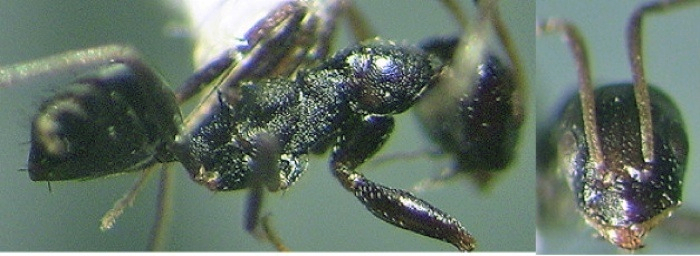 |
West
Africa
& Congo Basin - ambigua |
| -- |
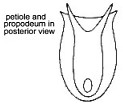 TL
> 2.5 mm; petiole
in face view relatively narrow, with
long sharp spines TL
> 2.5 mm; petiole
in face view relatively narrow, with
long sharp spines |
9 |
| 9 |
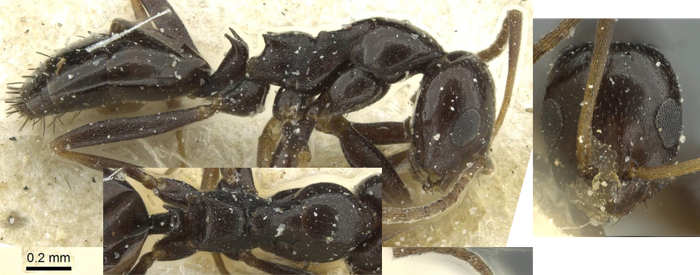 Body
colour nearer black; TL 2.3 mm, SI 125; head smaller and narrower,
scape
surpassing occiput by around 1/3 its own length; petiole spines
closer, with distance apart about the same as basal separation; head,
pronotum and gaster smooth and shiny brown Body
colour nearer black; TL 2.3 mm, SI 125; head smaller and narrower,
scape
surpassing occiput by around 1/3 its own length; petiole spines
closer, with distance apart about the same as basal separation; head,
pronotum and gaster smooth and shiny brown |
Zaïre -
schoutedeni |
| -- |
Body colour
predominantly brown |
10 |
| 10 |
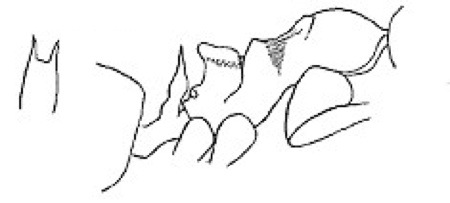 Petiole
as above; TL 3.1-3.4 mm, SL 121; eyes very convex and large; scape
surpassing
occiput by
less than 1/3 of own length; head with irregular puncturation; erect
hairs blackish and thick, with obtuse apices Petiole
as above; TL 3.1-3.4 mm, SL 121; eyes very convex and large; scape
surpassing
occiput by
less than 1/3 of own length; head with irregular puncturation; erect
hairs blackish and thick, with obtuse apices
|
|
| . |
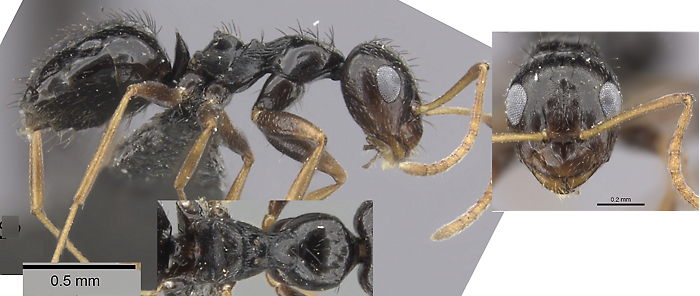 |
Eastern
& southern
Africa - incisa |
| 10A |
 TL
3.0-3.2 mm, CI 87, SI 136; head near circular in full face view; eyes
unusually small, ca 0.22 X length of side of head; scapes surpassing
occiput by well over half
its own length; body with head and
gaster brown, alitrunk and appendages distinctly paler, no more than
reddish brown to ochreous TL
3.0-3.2 mm, CI 87, SI 136; head near circular in full face view; eyes
unusually small, ca 0.22 X length of side of head; scapes surpassing
occiput by well over half
its own length; body with head and
gaster brown, alitrunk and appendages distinctly paler, no more than
reddish brown to ochreous |
. |
| . |
 |
Zimbabwe
- dendrophila |
| -- |
 TL 2.7-3.0 mm, CI ca
80; scapes long
surpassing occiput by more than two-fifths of own length, SI 133;
differs from ambigua as pronotum more impressed dorsally,
dorsum of
propodeum more concave, angles with more pronounced teeth and the
petiole scale (shown right) with longer spines, which are round in
cross-section, thicker at the base than the apex, and distinctly curve
backwards; also finer sculpturation than ambigua;
head alitrunk and petiole dark rusty red (dark burnt sienna), gaster
dark brown; gaster with thick bristly brownish-black erect hairs TL 2.7-3.0 mm, CI ca
80; scapes long
surpassing occiput by more than two-fifths of own length, SI 133;
differs from ambigua as pronotum more impressed dorsally,
dorsum of
propodeum more concave, angles with more pronounced teeth and the
petiole scale (shown right) with longer spines, which are round in
cross-section, thicker at the base than the apex, and distinctly curve
backwards; also finer sculpturation than ambigua;
head alitrunk and petiole dark rusty red (dark burnt sienna), gaster
dark brown; gaster with thick bristly brownish-black erect hairs
|
. |
| . |
 |
Zimbabwe
& South Africa - spinosior |
| -- |
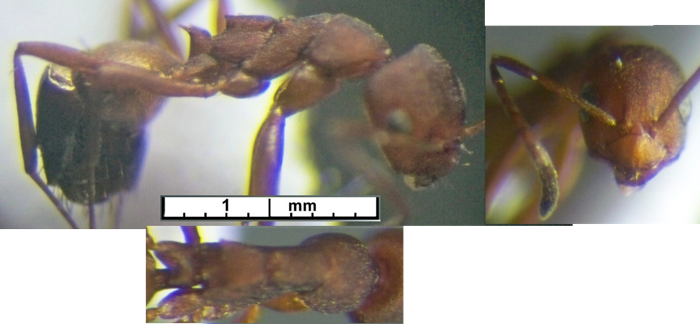 TL ca 2.7 mm, HL
0.58, HW 0.50, SL 0.65, PW 0.49; CI 73, SI 128 EI (eye length/HL) 28;
head in full face view sub-rectangular, occiptal corners quite sharply
rounded, eyes oval;deeply incised metanotal groove, propodeum dorsum
flat, with distinct longitudinal incavation, propodeum with short sharp
spines; petiole with long back-curved apical
spines; no erect hairs on head (other than clypeus) and alitrunk; dark
orange-brown, the gaster with a relatively pale base contrasting with
the posterior half, funiculi with a contrasting dark club; head with
fine surface
sculpture giving a matt appearance, alitrunk finely but densely
spiculate TL ca 2.7 mm, HL
0.58, HW 0.50, SL 0.65, PW 0.49; CI 73, SI 128 EI (eye length/HL) 28;
head in full face view sub-rectangular, occiptal corners quite sharply
rounded, eyes oval;deeply incised metanotal groove, propodeum dorsum
flat, with distinct longitudinal incavation, propodeum with short sharp
spines; petiole with long back-curved apical
spines; no erect hairs on head (other than clypeus) and alitrunk; dark
orange-brown, the gaster with a relatively pale base contrasting with
the posterior half, funiculi with a contrasting dark club; head with
fine surface
sculpture giving a matt appearance, alitrunk finely but densely
spiculate |
Liberia
- n
sp Liberia Yekepa |
 |
With abundant erect hairs |
-- |
| 11 |
Erect
hairs black; body colour variably brown to black |
12 |
| -- |
Erect hairs no
darker than brown |
13 |
| 12 |
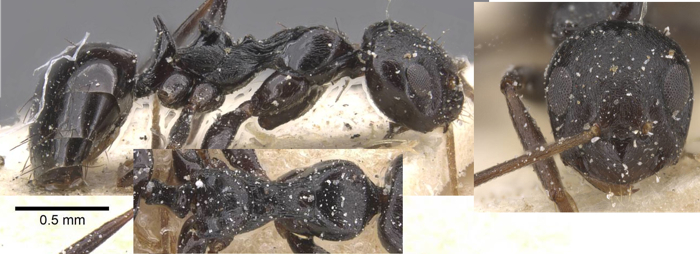 Erect hairs, sparse,
long
black and silky, but white pubescence; TL 2.5 mm, CI 90, SI 129; scape
surpassing
occiput by about one-third its own length; body generally black,
appendages brown; overall dull matt, except gaster shiny Erect hairs, sparse,
long
black and silky, but white pubescence; TL 2.5 mm, CI 90, SI 129; scape
surpassing
occiput by about one-third its own length; body generally black,
appendages brown; overall dull matt, except gaster shiny |
Zaïre -
gerardi |
| -- |
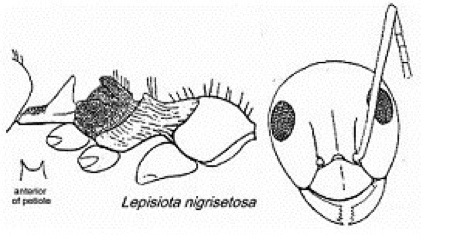 Erect
hairs long, black and abundant on head and
gaster; TL 3.2 mm, CI 88-94, SI 124-142; head a short oval; in full
face view eyes
not reaching sides of head; petiole scale distinctly triangular in
profile Erect
hairs long, black and abundant on head and
gaster; TL 3.2 mm, CI 88-94, SI 124-142; head a short oval; in full
face view eyes
not reaching sides of head; petiole scale distinctly triangular in
profile |
. |
| .. |
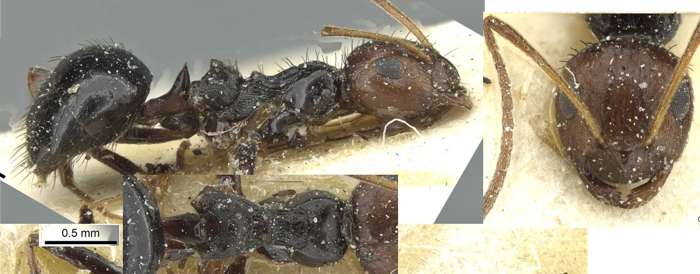 |
Zaïre
& Equatorial Guinea - nigrisetosa |
| -- |
 TL
3.3 mm, CI 92, SI 133; head ovate, eyes large;
propodeum with raised cone-shaped lateral processes; petiole with short
spines each terminating in a distinct hair; head closely reticulate and
dull; lateral alitrunk fairly strongly rugulose TL
3.3 mm, CI 92, SI 133; head ovate, eyes large;
propodeum with raised cone-shaped lateral processes; petiole with short
spines each terminating in a distinct hair; head closely reticulate and
dull; lateral alitrunk fairly strongly rugulose
|
. |
| . |
 |
Malawi
&
South Africa - mlanjiensis |
| -- |
Erect hairs other than black |
-- |
| 13 |
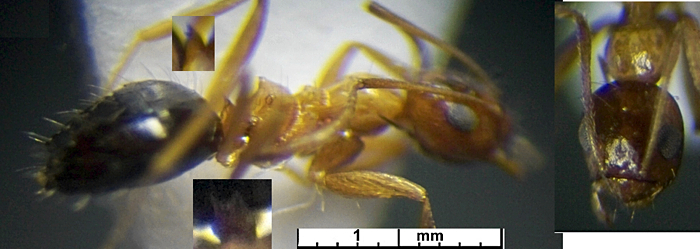 TL
1.7-2.0 mm, SI 160; erect
hairs short and whitish; body distinctly bicoloured, alitrunk reddish
yellow, head darker, gaster black; scapes surpass occiput by less than
two-fifths of own length; propodeal spiracles at apex of short processes TL
1.7-2.0 mm, SI 160; erect
hairs short and whitish; body distinctly bicoloured, alitrunk reddish
yellow, head darker, gaster black; scapes surpass occiput by less than
two-fifths of own length; propodeal spiracles at apex of short processes
Fresh specimen slightly larger than type
|
Cameroun
- nigriventris |
| -- |
Erect hairs long |
14 |
| 14 |
Body
black |
15 |
| -- |
Body brown
rather than black |
16 |
| 15 |
scape
without dense suberect pubescence |
15A |
| -- |
scape with dense suberect
pubescence |
15B |
| 15A |
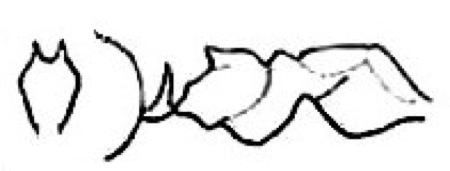 TL
3.0-3.4 mm, SI ca 120; head square, sides nearly
straight; scape surpassing occiput by about half its own length;
propodeum with distinct teeth; petiole narrow about one and a half
times as high as wide, with moderate spines; erect hairs thin, long and
dark brown; scapes with basal two-thirds ochreous TL
3.0-3.4 mm, SI ca 120; head square, sides nearly
straight; scape surpassing occiput by about half its own length;
propodeum with distinct teeth; petiole narrow about one and a half
times as high as wide, with moderate spines; erect hairs thin, long and
dark brown; scapes with basal two-thirds ochreous |
. |
| . |
 |
Zimbabwe
(?Ghana) - egregia |
| -- |
 Lacking erect hairs on the scapes; TL ca 2.9 mm, HL
0.73, HW 0.58, SL
0.85, CI 78, SI 158; propodeum with short sharp teeth, petiole with
long back-curved apical spines; abundant erect hairs; dark brown,
anterior of head lighter; antennae entirely yellow-brown, tarsi and
tibia same; head with very fine surface sculpture giving a matt
appearance, alitrunk finely but densely spiculate. Lacking erect hairs on the scapes; TL ca 2.9 mm, HL
0.73, HW 0.58, SL
0.85, CI 78, SI 158; propodeum with short sharp teeth, petiole with
long back-curved apical spines; abundant erect hairs; dark brown,
anterior of head lighter; antennae entirely yellow-brown, tarsi and
tibia same; head with very fine surface sculpture giving a matt
appearance, alitrunk finely but densely spiculate. |
Cameroun - Cameroun
fk sp2 |
| -- |
 TL
2.8-3.3 mm, CI 90, SI 126; jet black, except tibiae brown,
tarsi yellowish-brown, base of scape ochreous; shiny, even propodeum
which has longitudinal rugae; erect hairs abundant. TL
2.8-3.3 mm, CI 90, SI 126; jet black, except tibiae brown,
tarsi yellowish-brown, base of scape ochreous; shiny, even propodeum
which has longitudinal rugae; erect hairs abundant. |
. |
| . |
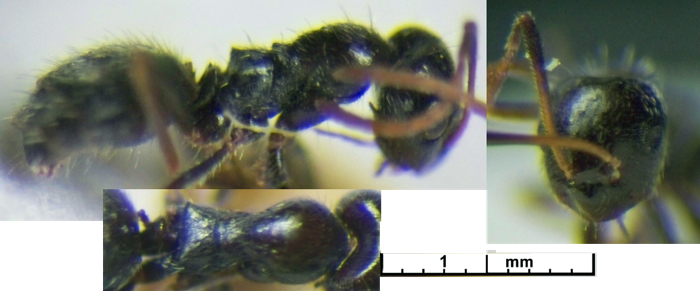 |
Eastern
Africa & Egypt (Sinai) - hirsuta |
| -- |
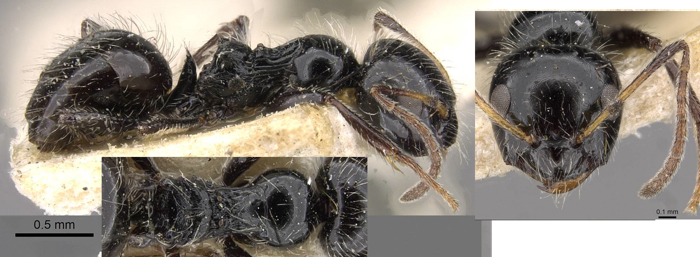 TL 2.5-2.8 mm, SI 105; head
ovoid (capensis shape); shorter scapes, surpassing
occiput by about 1/4 of own length; body fairly stocky; propodeum with
conical apices; all except metanotum and propodeum shiny; erect hairs
long and whitish, no obvious pubescence; black, except apices of
mandibles, most of antennae and tarsi reddish-brown to yellow TL 2.5-2.8 mm, SI 105; head
ovoid (capensis shape); shorter scapes, surpassing
occiput by about 1/4 of own length; body fairly stocky; propodeum with
conical apices; all except metanotum and propodeum shiny; erect hairs
long and whitish, no obvious pubescence; black, except apices of
mandibles, most of antennae and tarsi reddish-brown to yellow
|
South
Africa - junodi |
| -- |
 TL 2.4 mm, SL 110; head
ovoid (capensis shape); shorter scapes, surpassing
occiput by about 1/4 of own length; body fairly stocky; propodeum with
conical apices; all except metanotum and propodeum shiny; erect hairs
long and whitish, no obvious pubescence; black, except apices of
mandibles, most of antennae and tarsi reddish-brown to yellow - very
densely hairy, including on scapes TL 2.4 mm, SL 110; head
ovoid (capensis shape); shorter scapes, surpassing
occiput by about 1/4 of own length; body fairly stocky; propodeum with
conical apices; all except metanotum and propodeum shiny; erect hairs
long and whitish, no obvious pubescence; black, except apices of
mandibles, most of antennae and tarsi reddish-brown to yellow - very
densely hairy, including on scapes
|
South
Africa (?Cameroun) - crinita |
| -- |
Body no more than dark brown |
-- |
| 16 |
 Erect hairs dark; TL
2.86-3.08 mm, CI 91, SI 130; colour black or dark red-brown, with
yellow
tarsi. Sculpturation of fine striations on the pronotum, of rugae on
the mesonotum and propodeum. Erect hairs stout, dark, moderately
abundant on body and head. Propodeal prominences dentate but not
spinose. Petiole spines moderately developed and straight. Erect hairs dark; TL
2.86-3.08 mm, CI 91, SI 130; colour black or dark red-brown, with
yellow
tarsi. Sculpturation of fine striations on the pronotum, of rugae on
the mesonotum and propodeum. Erect hairs stout, dark, moderately
abundant on body and head. Propodeal prominences dentate but not
spinose. Petiole spines moderately developed and straight. |
. |
| . |
 |
Somalia;
? Benin & Eastern Africa
- validiuscula
|
| -- |
Erect hairs
pale, yellowish |
17 |
| 17 |
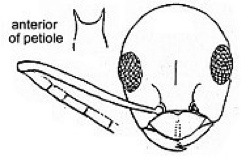 TL
2.0-2.2 mm, CI 91, SI 130; erect hairs few but
long, and yellow; head a distinct oval; with large eyes in full face
view protruding beyond the sides; long maxillary palps; apex of petiole
with moderately long posteriorly curved spines [NOTE head shape of guineensis
is ovoid if viewed titled backwards, so mandibles more exposed] TL
2.0-2.2 mm, CI 91, SI 130; erect hairs few but
long, and yellow; head a distinct oval; with large eyes in full face
view protruding beyond the sides; long maxillary palps; apex of petiole
with moderately long posteriorly curved spines [NOTE head shape of guineensis
is ovoid if viewed titled backwards, so mandibles more exposed] |
. |
| . |
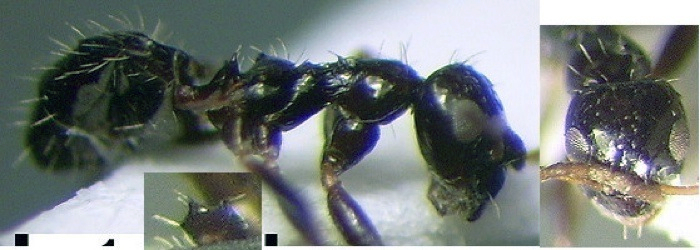 |
Zaïre
&
Sudan - palpalis |
| -- |
 TL 2.5-2.7 mm, CI 91,
SI 129-137; erect
hairs pale, moderately long and fairly abundant; sole sculpturation
long rugae on lateral mesonotum; petiole scale with distinct spines;
colour variable brown to black-brown TL 2.5-2.7 mm, CI 91,
SI 129-137; erect
hairs pale, moderately long and fairly abundant; sole sculpturation
long rugae on lateral mesonotum; petiole scale with distinct spines;
colour variable brown to black-brown
|
. |
| . |
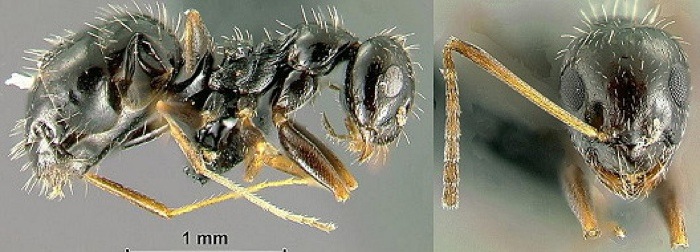 |
West
Africa
- guineensis |
 |
Petiole emarginate or with no more
than short spines or denticles |
-- |
| 18 |
Highly
elongated with very long appendages, scapes more than twice the length
of the head |
19 |
| -- |
Not greatly
elongated |
20 |
| 19 |
 Median
ocellus set at about
the posterior level of the eyes; TL ca 3.7 mm (range 2.5-5); HW 0.7 HL
0.7 PW 0.5 AL 1.5 Hind tibia 1.6; CI 85 SI 194-200 EL/HW 0.32; dark
brown-black, except for brownish-yellow appendages, overall appearance
dull; almost hairless Median
ocellus set at about
the posterior level of the eyes; TL ca 3.7 mm (range 2.5-5); HW 0.7 HL
0.7 PW 0.5 AL 1.5 Hind tibia 1.6; CI 85 SI 194-200 EL/HW 0.32; dark
brown-black, except for brownish-yellow appendages, overall appearance
dull; almost hairless |
Ethiopia,
Senegal, Sudan, Egypt & Middle East
- gracilicornis |
| -- |
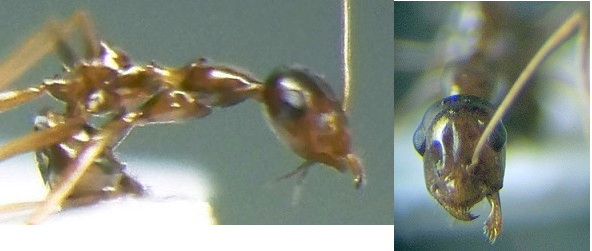 Median
ocellus set well back from posterior
level of the eyes; TL ca 3.0 mm; HW 0.6 HL 0.82 PW 0.42 AL 1.3; hind
tibia 1.5; CI 82 SI 192 EL/HW 0.37; shiny chestnut brown, head slightly
darker; almost without pubescence Median
ocellus set well back from posterior
level of the eyes; TL ca 3.0 mm; HW 0.6 HL 0.82 PW 0.42 AL 1.3; hind
tibia 1.5; CI 82 SI 192 EL/HW 0.37; shiny chestnut brown, head slightly
darker; almost without pubescence |
Sudan - omeri |
| -- |
 Propodeum with sharp spines;
median
ocellus set just forward
the posterior level of the eyes; TL ca 3.5 mm (range 2.5-3.5); HW 0.6
HL
0.7 PW 0.4 AL 1.4 Hind tibia 1.6; CI 85 SI 215 EL/HW 0.40; dark
brown-black, except for brownish-yellow appendages; overall appearance
shiny; almost hairless Propodeum with sharp spines;
median
ocellus set just forward
the posterior level of the eyes; TL ca 3.5 mm (range 2.5-3.5); HW 0.6
HL
0.7 PW 0.4 AL 1.4 Hind tibia 1.6; CI 85 SI 215 EL/HW 0.40; dark
brown-black, except for brownish-yellow appendages; overall appearance
shiny; almost hairless |
Tunisia
- ajjer |
|
Not highly elongated |
-- |
| 20 |
Small
species, TL 2.2 mm or less, with very short or no pilosity; body not
entirely black or dark brown |
21 |
| -- |
Mostly larger
species, TL > 2.2 mm; body entirely or in greater part black or
dark brown |
29 |
| -- |
TL < 2.2 mm and with no more
than very short pilosity
|
-- |
| 21 |
Whole
body very smooth and shining |
22 |
| -- |
 TL
1.6-1.9 mm, CI ca 90, SI 100; scapes just reach occiput; whole
body dull; head and thorax bright red, gaster dark brown TL
1.6-1.9 mm, CI ca 90, SI 100; scapes just reach occiput; whole
body dull; head and thorax bright red, gaster dark brown |
.
|
.
|
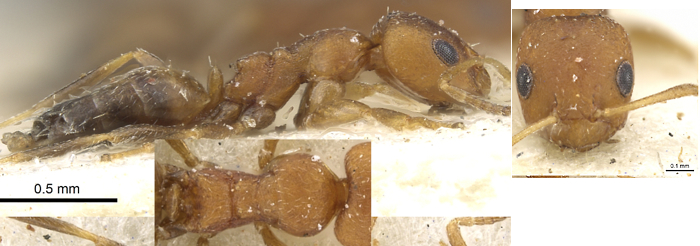
|
Zimbabwe
- foreli |
| --
|
TL
1.6-1.9 mm, CI ca 90, SI 110; scapes just reach occiput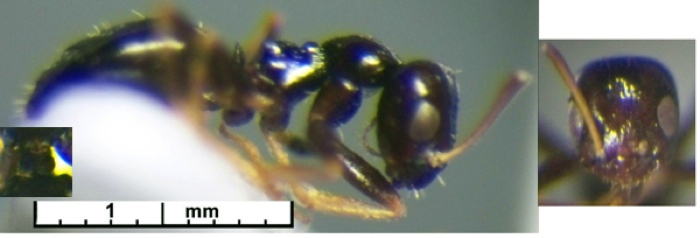
|
Sudan
- Sudan
JM073 |
| 22 |
Scapes
just surpass occiput |
23 |
| . |
Scapes surpass
occiput by about one third of own length |
26 |
| 23 |
Generally
unicolourous |
24 |
| . |
With alitrunk,
at least, distinctly lighter than head and gaster |
25 |
| 24 |
 TL 1.8
mm, CI 93, SI 92; quite dark reddish brown TL 1.8
mm, CI 93, SI 92; quite dark reddish brown |
Angola
&
Gabon - mota |
| -- |
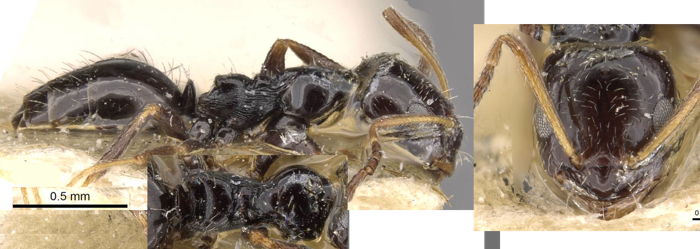 TL 1.5 mm, SI 100;
scapes just surpassing occiput; jet black TL 1.5 mm, SI 100;
scapes just surpassing occiput; jet black |
South
Africa - minuta |
| 25 |
 TL
1.7-1.9 mm, SI 100; head subquadrate; scapes longer than simplex ?; thorax ferruginous, head
and gaster dark
brown (variety avunculus
TL 2.3-2.5 mm) TL
1.7-1.9 mm, SI 100; head subquadrate; scapes longer than simplex ?; thorax ferruginous, head
and gaster dark
brown (variety avunculus
TL 2.3-2.5 mm) |
Zimbabwe
- rubrovaria |
| -- |
 TL 1.7-2.0 mm, SI 100; head about 1/6
longer than wide;
entirely shining; dark-reddish ochreous (deep orange-yellow), apex of
gaster blackish TL 1.7-2.0 mm, SI 100; head about 1/6
longer than wide;
entirely shining; dark-reddish ochreous (deep orange-yellow), apex of
gaster blackish |
Zimbabwe & South
Africa - arnoldi |
| -- |
Scapes surpass
occiput by about one third of own length |
-- |
| 26 |
Overall
colour orange or red-brown
|
27 |
| -- |
Colour dark brown to black
|
28 |
| 27 |
 Small, occiput near straight; eyes almost flat and
slightly inset into surface of head, narrow ovoid ca 1.7 longer than
wide (0.37 X length of side of head); pronotum shallowly convex, in
dorsal view alitrunk short and relatively wide (pronotum wider than
length of promesonotum); petiole emarginate, moderately thick; legs
unusually short with wide, seemingly flattened femora; sparse short
yellow pilosity on gaster only (ca 0.05 mm); shiny unsculptured,
alitrunk yellow brown, head and gaster darker; Small, occiput near straight; eyes almost flat and
slightly inset into surface of head, narrow ovoid ca 1.7 longer than
wide (0.37 X length of side of head); pronotum shallowly convex, in
dorsal view alitrunk short and relatively wide (pronotum wider than
length of promesonotum); petiole emarginate, moderately thick; legs
unusually short with wide, seemingly flattened femora; sparse short
yellow pilosity on gaster only (ca 0.05 mm); shiny unsculptured,
alitrunk yellow brown, head and gaster darker;
TL ca 1.7 mm, HL 0.49, HW 0.42, CI 83, SL 0.50, SI 121, PW 0.30 |
Lepisiota nsp Sudan JM074 |
| -- |
|
|
| 28 |
 TL 1.7
mm, CI 90, SI 100; head rectangular,
as wide in front as behind; scape surpasses occiput by 1/3 its own
length; quite deep promesonotal suture; shiny black, basal third of
scape and tarsi clear yellow, rest of appendages brown TL 1.7
mm, CI 90, SI 100; head rectangular,
as wide in front as behind; scape surpasses occiput by 1/3 its own
length; quite deep promesonotal suture; shiny black, basal third of
scape and tarsi clear yellow, rest of appendages brown |
. |
| . |
 |
Senegal
east across to Sudan - laevis |
| -- |
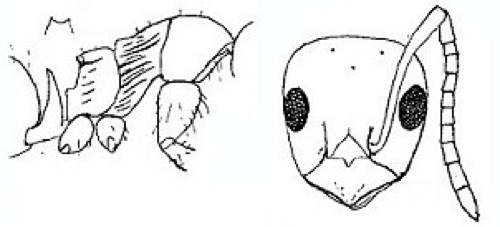 TL 2
mm, CI 85, SI 110; scape surpasses occiput by 1/3 its own
length; altrunk convex transversely; propodeum with prominent cones;
petiole fairly deeply emarginate, almost bidentate; almost no erect
hairs, those seen are whitish, short and blunt; pubescence very sparse;
entirely smooth & shining, except deeply striate mandibles;
black TL 2
mm, CI 85, SI 110; scape surpasses occiput by 1/3 its own
length; altrunk convex transversely; propodeum with prominent cones;
petiole fairly deeply emarginate, almost bidentate; almost no erect
hairs, those seen are whitish, short and blunt; pubescence very sparse;
entirely smooth & shining, except deeply striate mandibles;
black |
. |
| . |
 |
Southern
Africa
- alexis |
 |
TL in most > 2.2 mm |
-- |
| 29 |
Overall
colour pale brown to orange
|
30 |
| -- |
Colour dark brown to black
|
32 |
| 30 |
 Head sub-circular, in profile also sub-circular; frons
with a long median impression; eyes moderate and set more or less on
the front of the face, so that hardly breaking outline of sides (0.328
X length of side of head); scape unusually thick and apically widening;
petiole scale with quite narrow profile, as high as the propodeal
declivity; erect hairs abundant and quite thick (ca 0.12 mm long); base
colour dusky yellow to dull yellow-grey, appearance overall is dull Head sub-circular, in profile also sub-circular; frons
with a long median impression; eyes moderate and set more or less on
the front of the face, so that hardly breaking outline of sides (0.328
X length of side of head); scape unusually thick and apically widening;
petiole scale with quite narrow profile, as high as the propodeal
declivity; erect hairs abundant and quite thick (ca 0.12 mm long); base
colour dusky yellow to dull yellow-grey, appearance overall is dull
TL ca 2.6 mm, HL 0.68, HW 60, CI 89, SL 0.73, SI 128, PW 0.40
|
Lepisiota nsp Sudan JMIT6 |
| -- |
Overall appearance shiny |
31 |
| 31 |
 Head subsquare, widest at level of the eyes; eyes ovoid
strongly convex (0.37 X length of side of head); in profile head ovoid
with weakly convex lower side; clypeus with a weak median carina
running right to anterior margin; pronotum dorsally flattened; petiole
narrow and emarginate apically; abundant sub-erect yellow pilosity (ca
0.13 mm long) and abundant appressed pubescence, giving a shaggy
appearance to the head; shiny, unsculptured, but with mesonotum and
propodeum weakly spiculate, very distinctive broad metanotal groove
with marked rugae; near unicolorous yellow brown Head subsquare, widest at level of the eyes; eyes ovoid
strongly convex (0.37 X length of side of head); in profile head ovoid
with weakly convex lower side; clypeus with a weak median carina
running right to anterior margin; pronotum dorsally flattened; petiole
narrow and emarginate apically; abundant sub-erect yellow pilosity (ca
0.13 mm long) and abundant appressed pubescence, giving a shaggy
appearance to the head; shiny, unsculptured, but with mesonotum and
propodeum weakly spiculate, very distinctive broad metanotal groove
with marked rugae; near unicolorous yellow brown
TL ca 3.0 mm, HL 0.68, HW 0.57, CI 88, SL 0.82, SI 135
|
Lepisiota
nsp Sudan 2009-29 |
| -- |
 Very distinctive shiny unsculptured, yellow brown,
gaster darker;
pronotum dorsally flattened; head sub-square, widest behind the eyes;
eyes ovoid moderately convex (0.37 X length of side of head); in
profile head sub-circular with broadly convex lower side; clypeus with
strong median carina running right to anterior margin; propodeum dorsum
with distinctive longitudinal septum; petiole narrow and emarginate
apically; abundant erect yellow pilosity (ca 0.16 mm long) Very distinctive shiny unsculptured, yellow brown,
gaster darker;
pronotum dorsally flattened; head sub-square, widest behind the eyes;
eyes ovoid moderately convex (0.37 X length of side of head); in
profile head sub-circular with broadly convex lower side; clypeus with
strong median carina running right to anterior margin; propodeum dorsum
with distinctive longitudinal septum; petiole narrow and emarginate
apically; abundant erect yellow pilosity (ca 0.16 mm long)
TL ca 2.7 mm, HL 0.68, HW 0.58, CI 90, SL 0.73, SI 13 |
Lepisiota nsp Sudan JM362
|
| -- |
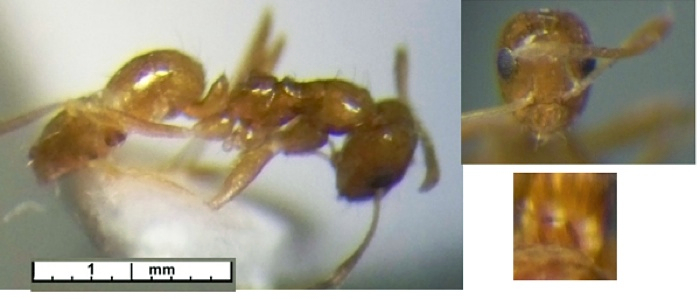 Head elongated ovoid, widest behind the eyes, occiput
weakly concave; eyes sub-circular weakly convex (0.35 X length of side
of head); in profile head sub-circular with lower side almost as convex
as upper; clypeus without a median carina; pronotum dorsally flattened;
propodeum with trinagular teeth; petiole short and thick in profile,
emarginate apically; sparse short erect yellow pilosity (ca 0.08 mm
long); shiny, wholly unsculptured; uniform yellow brown Head elongated ovoid, widest behind the eyes, occiput
weakly concave; eyes sub-circular weakly convex (0.35 X length of side
of head); in profile head sub-circular with lower side almost as convex
as upper; clypeus without a median carina; pronotum dorsally flattened;
propodeum with trinagular teeth; petiole short and thick in profile,
emarginate apically; sparse short erect yellow pilosity (ca 0.08 mm
long); shiny, wholly unsculptured; uniform yellow brown
TL ca 2.5 mm, HL 0.62, HW 0.48, CI 70, SL 0.72, SI 145 |
Lepisiota
nsp Sudan 2009-49 |
 |
Colour dark brown to black
|
-- |
| 32 |
Overall
colour very shiny black |
33 |
| -- |
Colour no more
than dark brown |
34 |
| 33 |
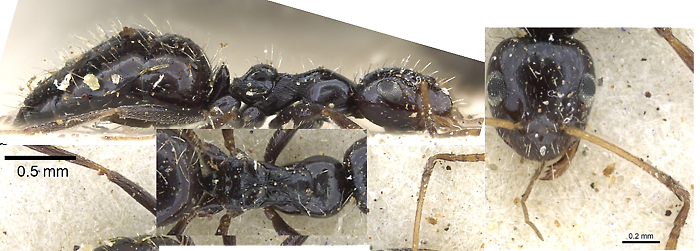 Black,
except for brownish-yellow appendages, with a distinctive and unique
metallic sheen, greenish on the head and thorax, violaceous on the
gaster; pilosity of long, erect whitish hairs; TL 3.2-3.8 mm, SI 130;
CI ca
90?, scape reaching back past occiput by about 1/3 of its length;
pronotum dorsally flattened Black,
except for brownish-yellow appendages, with a distinctive and unique
metallic sheen, greenish on the head and thorax, violaceous on the
gaster; pilosity of long, erect whitish hairs; TL 3.2-3.8 mm, SI 130;
CI ca
90?, scape reaching back past occiput by about 1/3 of its length;
pronotum dorsally flattened
|
Zimbabwe
& Angola - submetallica |
| -- |
 Head
almost square and scapes unusually short; eyes quite small, only ca
0.30 X length of side of head; very
shiny black and almost unsculptured but
without a metallic sheen; pilosity limited to longish white hairs on
anterior of head, propodeum and gaster; TL ca 3.0 mm, CI 95, SI 104 Head
almost square and scapes unusually short; eyes quite small, only ca
0.30 X length of side of head; very
shiny black and almost unsculptured but
without a metallic sheen; pilosity limited to longish white hairs on
anterior of head, propodeum and gaster; TL ca 3.0 mm, CI 95, SI 104
|
Congo - new species - zassii |
| 34 |
Erect
hairs relatively short, may be sparse |
35 |
| -- |
Erect hairs
long and abundant |
43 |
| 35 |
Erect
hairs brown |
36 |
| -- |
Erect hairs
whitish and eyes not breaking outline of head in full face view |
39 |
| 36 |
Head
and alitrunk shiny |
37 |
| -- |
Head and
alitrunk matt |
38 |
| 37 |
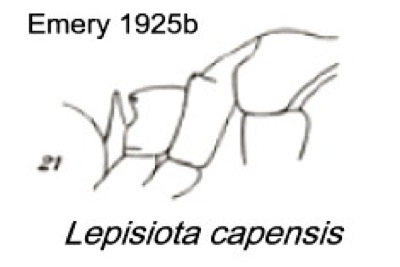 TL ca
2.0 mm, CI 100, SI 133, head in full face view near ovoid, occiput
straight; shiny, appendages yellow;
propodeum sculptured; petiole scale simply dentate TL ca
2.0 mm, CI 100, SI 133, head in full face view near ovoid, occiput
straight; shiny, appendages yellow;
propodeum sculptured; petiole scale simply dentate |
. |
| . |
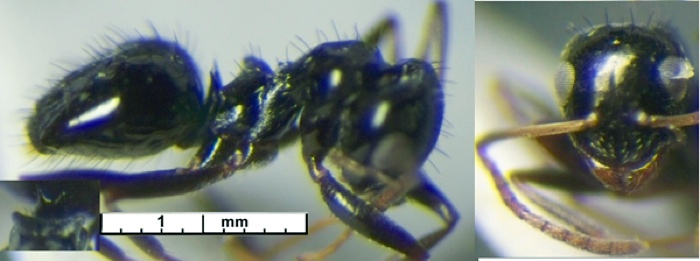 |
Southern
and
eastern African - capensis |
| -- |
 TL
2.2-2.3 mm, CI 86, SI 130; head laterally and occiput
convex; eyes slightly convex, occupying about one-third length
of head and set a little forward of the mid-point of the head; scape
surpassing occiput by about half its own length; petiole feebly oval,
with small teeth at each side of summit; mostly subopaque with dense
striations, finer on the head, gaster smooth and shiny; erect pilosity
black and setiform, longer than on capensis,
abundant on the gaster; pubescence sparse and pale; black but with
metallic violaceous blue sheen, appendages rust, funiculi brown; TL
2.2-2.3 mm, CI 86, SI 130; head laterally and occiput
convex; eyes slightly convex, occupying about one-third length
of head and set a little forward of the mid-point of the head; scape
surpassing occiput by about half its own length; petiole feebly oval,
with small teeth at each side of summit; mostly subopaque with dense
striations, finer on the head, gaster smooth and shiny; erect pilosity
black and setiform, longer than on capensis,
abundant on the gaster; pubescence sparse and pale; black but with
metallic violaceous blue sheen, appendages rust, funiculi brown; |
. |
| . |
 |
East Africa
- depressa |
| -- |
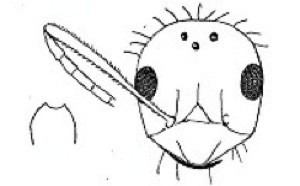 TL 2.7-2.9 mm, CI 100, SI 132,
head in full face view near ovoid, occiput
straight; shiny, appendages dark;
propodeum sculptured; petiole scale simply dentate TL 2.7-2.9 mm, CI 100, SI 132,
head in full face view near ovoid, occiput
straight; shiny, appendages dark;
propodeum sculptured; petiole scale simply dentate |
. |
| . |
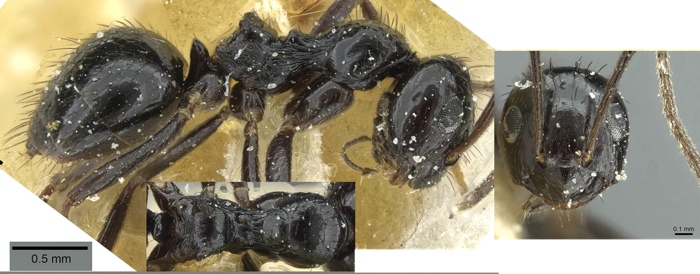 |
Kenya -
affinis |
|
Head & alitrunk matt |
- |
| 38 |
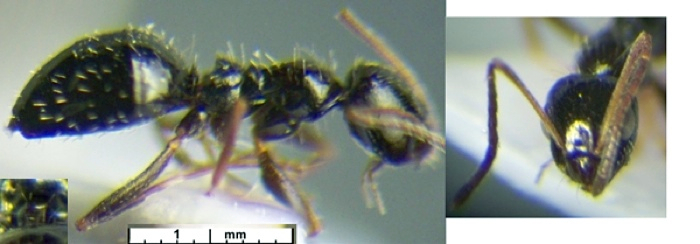 similar
to capensis but larger, TL 2.0-2.7 mm, SI 120; head and
alitrunk matt,
gaster shiny; pubescent, with sparse yellow erect hairs; blackish similar
to capensis but larger, TL 2.0-2.7 mm, SI 120; head and
alitrunk matt,
gaster shiny; pubescent, with sparse yellow erect hairs; blackish
|
Somalia
& Sudan
(Arabia) - carbonaria |
--
|
TL 2.5 mm; head wider than
long;
head and promesonotum shiny, finely punctate; metanotum and propodeum
subopaque/matt, gaster densely punctate; black, femora and antennal
club brown; gaster with yellowish pubescence; erect pilosity pale yellow
|
subsp.
baumi |
| -- |
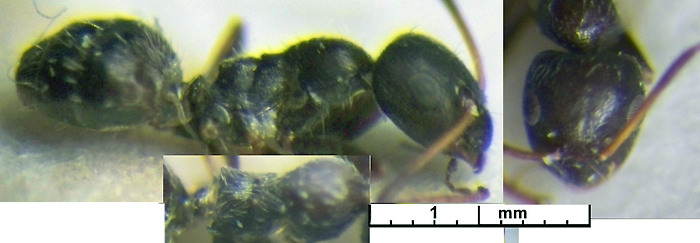 TL 1.6-2.4 mm, CI 82,
SI 150; head longer
than wide, with convex sides; matt, brown, appendages reddish, gaster
metallic bronze (carbonaria relative) TL 1.6-2.4 mm, CI 82,
SI 150; head longer
than wide, with convex sides; matt, brown, appendages reddish, gaster
metallic bronze (carbonaria relative) |
Egypt (Sinai) & Eritrea
(Ethiopia) - erythraea |
 |
Erect hairs whitish and eyes not
breaking outline of head in full face view |
- |
| 39 |
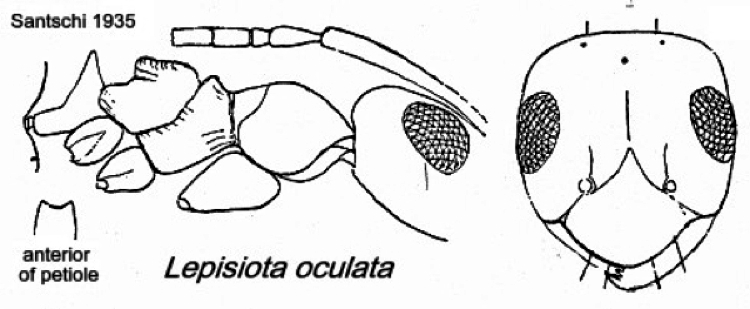 TL
2.4 mm, CI 80, SI ca 123; erect hairs very few but
white and sparse pubescence; head rectangular; eyes large and in full
face view unusually angled TL
2.4 mm, CI 80, SI ca 123; erect hairs very few but
white and sparse pubescence; head rectangular; eyes large and in full
face view unusually angled |
|
| . |
 |
Congo
Basin - oculata |
| -- |
Abundant
whitish pubescence; head relatively square |
40 |
| 40 |
Petiole
scale with narrow profile; erect hairs only moderately abundant |
41 |
| -- |
Petiole scale a
quite low thick node; erect hairs quite abundant |
42 |
| 41 |
 Scape surpassing occiput by
> one-third of own length, TL 2.2-2.4 mm, SI 134; erect hairs
coarse and sparse, yellowish-white Scape surpassing occiput by
> one-third of own length, TL 2.2-2.4 mm, SI 134; erect hairs
coarse and sparse, yellowish-white |
. |
| . |
 |
Somalia,
Sudan
(& Egypt) - depilis |
| . |
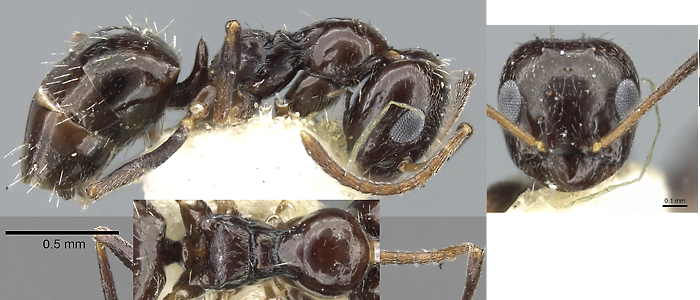 |
South
Sudan - issore |
| -- |
 TL 2.3-2.5 mm, CI 88,
SI 103 but 117-124
on fresh Sudan specimens; head somewhat wider and more truncate than depilis,
with scape surpassing occiput by < one-third of own length; eyes
quite small TL 2.3-2.5 mm, CI 88,
SI 103 but 117-124
on fresh Sudan specimens; head somewhat wider and more truncate than depilis,
with scape surpassing occiput by < one-third of own length; eyes
quite small |
. |
| . |
 |
Somalia
& Sudan - curta |
| 42 |
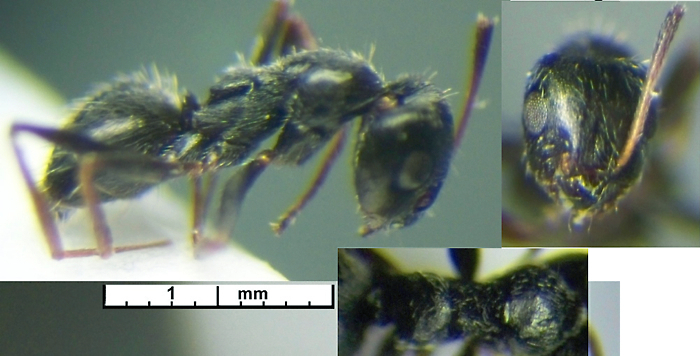 With
dense covering of coarse whitish hairs
(dimorphic), legs long, femora with dense long pubescence; TL >
2 mm, CI 87, SI 124; propodeum profile with almost flat dorsum With
dense covering of coarse whitish hairs
(dimorphic), legs long, femora with dense long pubescence; TL >
2 mm, CI 87, SI 124; propodeum profile with almost flat dorsum |
Eritrea
(also
Sinai & Arabia) - obtusa |
| -- |
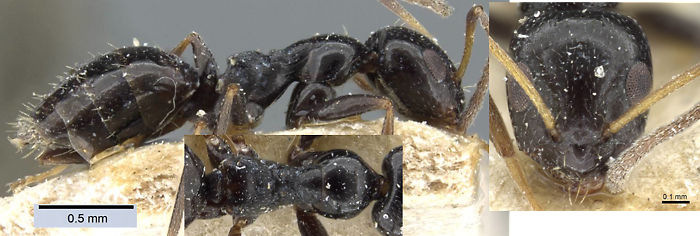 TL 2.4-2.7 mm, CI 90,
SI 107 [like simplex]
propodeum simply enlarged and angular posteriorly; petiole scale feebly
scalloped without teeth; [like depilis] moderately
abundant yellowish-white pilosity, pubescence sparse white appressed TL 2.4-2.7 mm, CI 90,
SI 107 [like simplex]
propodeum simply enlarged and angular posteriorly; petiole scale feebly
scalloped without teeth; [like depilis] moderately
abundant yellowish-white pilosity, pubescence sparse white appressed |
Congo Basin
- anceps |
 |
Erect hairs long and abundant |
-- |
| 43 |
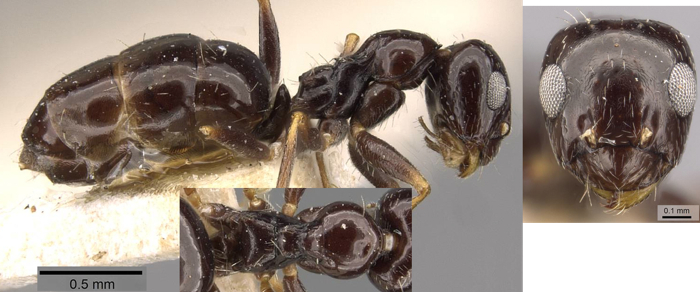 Erect
hairs dark brown; TL 2.3-2.8 mm, SI 110 (simplicoides); black, tarsi and
mandibles
brownish-yellow Erect
hairs dark brown; TL 2.3-2.8 mm, SI 110 (simplicoides); black, tarsi and
mandibles
brownish-yellow |
eastern
&
southern Africa - simplex |
| -- |
Erect hairs no
more than yellow brown |
44 |
| 44 |
Erect
hairs noticeably coloured, at least yellow brown |
45 |
| -- |
Erect hairs
whitish or colourless |
47 |
| -- |
Erect hairs yellowish to brown |
-- |
| 45 |
 TL
2.7-2.9 mm, CI 82, SI 124; erect hairs brown and
lacking on inferior border of femur; eyes about one-third of face in
size, reaching sides of face; scapes surpassing occiput by about half
their own length; black, smooth and shining TL
2.7-2.9 mm, CI 82, SI 124; erect hairs brown and
lacking on inferior border of femur; eyes about one-third of face in
size, reaching sides of face; scapes surpassing occiput by about half
their own length; black, smooth and shining |
Senegal
east across to
Sudan - acholli |
| -- |
Erect hairs
yellow-brown |
46 |
| 46 |
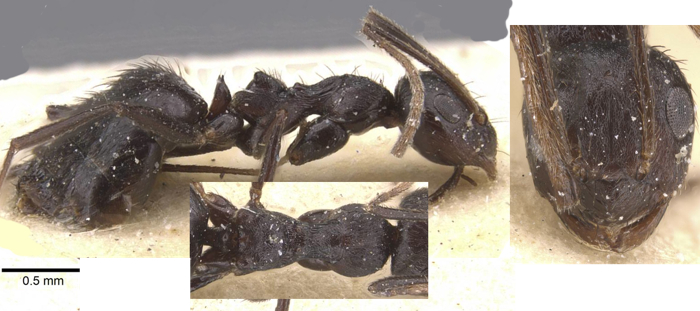 TL
2.7 mm, SI 140; head slightly longer than wide; with head in full face
view
eyes barely reaching the sides of the head; petiole scale with short
teeth; with long pointed hairs on the inferior border of the femur;
head finely and densely puncturate, alitrunk strongly striated, both
matt;
black, scape, femora and tibia dark brown TL
2.7 mm, SI 140; head slightly longer than wide; with head in full face
view
eyes barely reaching the sides of the head; petiole scale with short
teeth; with long pointed hairs on the inferior border of the femur;
head finely and densely puncturate, alitrunk strongly striated, both
matt;
black, scape, femora and tibia dark brown |
Zaïre -
piliscapa |
| -- |
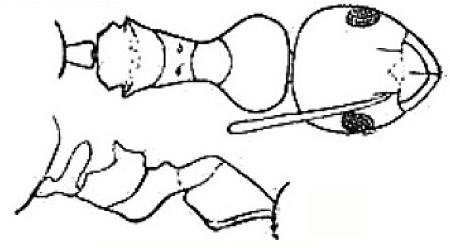 TL
3.4-3.8 mm, CI 92, SI 136; separable by greater size
and deep mesonotal and metanotal sutures, plus a peculiarly raised
propodeum; petiole scale emarginate; head, and most of alitrunk very
finely and densely granulate, mesonotum and propodeum laterally sharply
and longitudinally striate; dark brown, gaster black TL
3.4-3.8 mm, CI 92, SI 136; separable by greater size
and deep mesonotal and metanotal sutures, plus a peculiarly raised
propodeum; petiole scale emarginate; head, and most of alitrunk very
finely and densely granulate, mesonotum and propodeum laterally sharply
and longitudinally striate; dark brown, gaster black
|
. |
| . |
 |
Mozambique - silvicola |
 |
Erect hairs abundant and whitish |
-- |
47
|
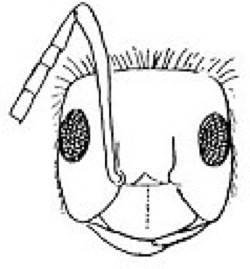 Head
distinctly square in full face view Head
distinctly square in full face view |
48 |
| -- |
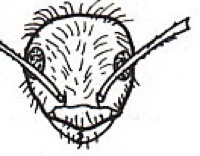 Head
oval or nearly so Head
oval or nearly so |
51 |
| -- |
Squarish head |
-- |
| 48 |
 Head distinctly
square, with
barely rounded corners Head distinctly
square, with
barely rounded corners |
49 |
| -- |
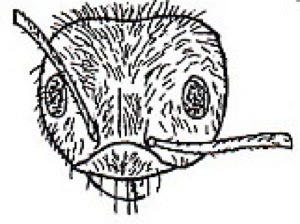 Head
square but with rounder corners Head
square but with rounder corners |
50 |
| 49 |
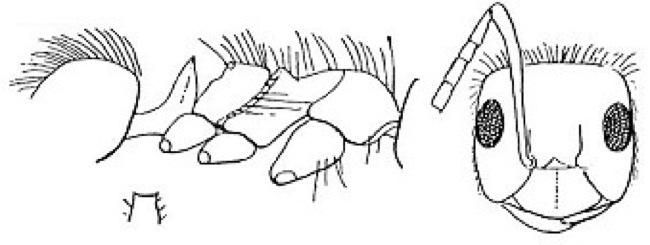 TL 2.3 mm, CI 94, SI (major?)
93; eyes
in
full face view reaching edges; erect hairs long white and very
abundant; smooth and shiny TL 2.3 mm, CI 94, SI (major?)
93; eyes
in
full face view reaching edges; erect hairs long white and very
abundant; smooth and shiny
Minor SI 135 - below
|
. |
| . |
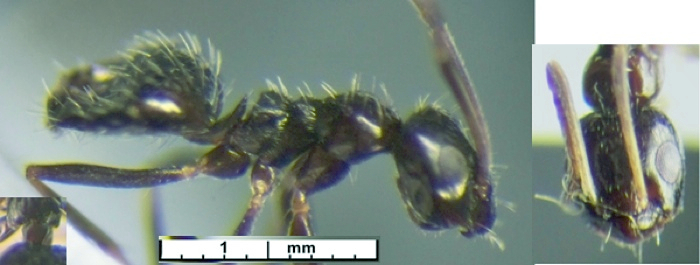 |
Zaïre
& Sudan - albata |
| -- |
 TL
1.8-2.2 mm, CI 86, SI 100; eyes protruding from
sides of head; hairs on head and thorax sparse; appearance entirely
dull; due to unique very fine scabrous sculpture TL
1.8-2.2 mm, CI 86, SI 100; eyes protruding from
sides of head; hairs on head and thorax sparse; appearance entirely
dull; due to unique very fine scabrous sculpture |
Zimbabwe - quadraticeps |
| 50 |
 Apparently dimorphic,
major TL 3.2-3.6 mm, CI 103-115, SI
79-82; in full face
view eyes distant from edges of face Apparently dimorphic,
major TL 3.2-3.6 mm, CI 103-115, SI
79-82; in full face
view eyes distant from edges of face |
. |
| . |
 |
West
Africa - cacozela |
| -- |
 TL 2.0 mm, SI 106; eyes
convex, larger than 1/3 of side of face; scapes surpassing occiput by
1/4 of own length; colour of erect hairs not given but no more than
moderate in length; black, basal half of scape, articulations of legs
and tarsi rust; very shiny and smooth TL 2.0 mm, SI 106; eyes
convex, larger than 1/3 of side of face; scapes surpassing occiput by
1/4 of own length; colour of erect hairs not given but no more than
moderate in length; black, basal half of scape, articulations of legs
and tarsi rust; very shiny and smooth
|
Eastern
Africa (maybe also Guinea) - imperfecta |
 |
Ovoid head |
-- |
| 51 |
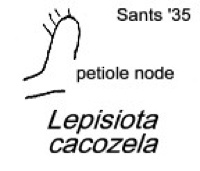 TL 2.6
mm, CI 92, SI 123; eyes quite small; petiole scale low only about 2/3
height of propodeal declivity and thick; erect
hairs white and very abundant, ca 0.15 mm long; dark brown to near
black, antennae wholly yellow-brown (based on fresh specimens) TL 2.6
mm, CI 92, SI 123; eyes quite small; petiole scale low only about 2/3
height of propodeal declivity and thick; erect
hairs white and very abundant, ca 0.15 mm long; dark brown to near
black, antennae wholly yellow-brown (based on fresh specimens) |
.
|
| . |
 |
West
Africa
& Congo Basin - cacozela
|
| -- |
Petiole with slender profile |
52 |
| 52 |
Scapes
within only fine appressed pubescence
|
53
|
| -- |
Scapes with dense sub-erect
pubescence
|
54 |
| 53 |
 TL
2.2 mm, CI 92, SI 140; relatively large eyes; propodeum
relatively short, high petiole scale; funiculus with shorter segments
than canescens; little pubescence and solely long
hairs; smooth and shiny TL
2.2 mm, CI 92, SI 140; relatively large eyes; propodeum
relatively short, high petiole scale; funiculus with shorter segments
than canescens; little pubescence and solely long
hairs; smooth and shiny
|
. |
| . |
 West Africa form West Africa form |
Angola
&
West Africa - monardi |
| -- |
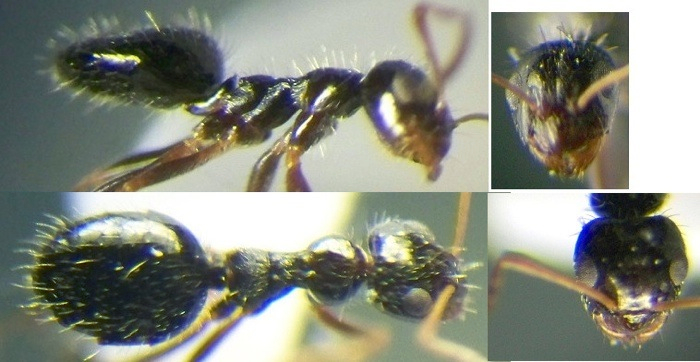 Petiole lower
than propodeal dorsumTL
2.0-2.5 mm; CI 89, SI 118; black and shining;
petiole moderately indented; dense covering of whitish hairs a mixture
of long and short hairs, femora without hairs Petiole lower
than propodeal dorsumTL
2.0-2.5 mm; CI 89, SI 118; black and shining;
petiole moderately indented; dense covering of whitish hairs a mixture
of long and short hairs, femora without hairs |
Sahel
zone or
fringes thereof - canescens |
| 54 |
 TL
1.7 mm, CI 93, SI 100; black and shining, head
subrectangular; petiole scale at least dentate TL
1.7 mm, CI 93, SI 100; black and shining, head
subrectangular; petiole scale at least dentate |
. |
| . |
 |
Angola
&
Gabon - ngangela |
| -- |
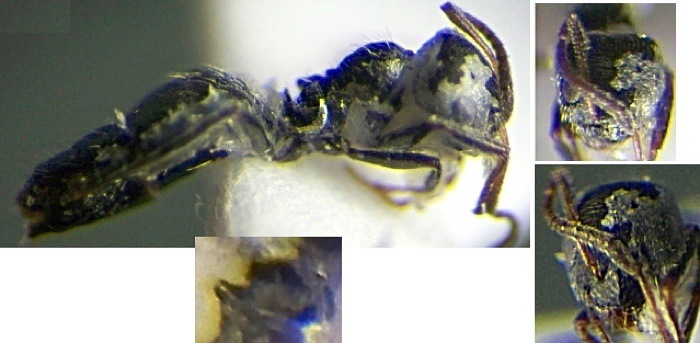 TL
1.8-2.0 mm, CI 91, SI 100; scape surpasses occiput by less
than one-third its own length; erect hairs very fine, propodeum smooth;
petiole scale oval from front, summit near straight; scapes with dense
sub-erect pubescence TL
1.8-2.0 mm, CI 91, SI 100; scape surpasses occiput by less
than one-third its own length; erect hairs very fine, propodeum smooth;
petiole scale oval from front, summit near straight; scapes with dense
sub-erect pubescence
|
Zaïre
& Congo - tenuipilis |
![]() Type location South
Africa (Mayr, 1862: 699, worker; Mayr, 1862: 770, male; also Mayr,
1866: 57, male; Emery, 1877b: 366, queen)
Type location South
Africa (Mayr, 1862: 699, worker; Mayr, 1862: 770, male; also Mayr,
1866: 57, male; Emery, 1877b: 366, queen)